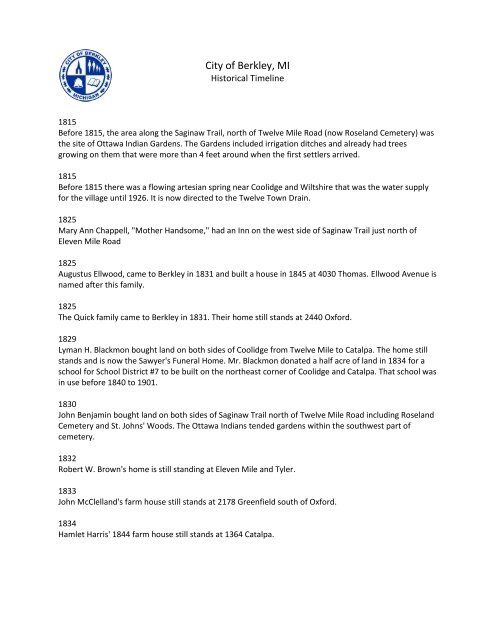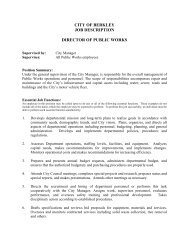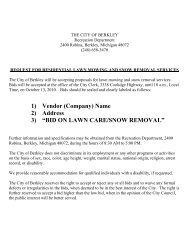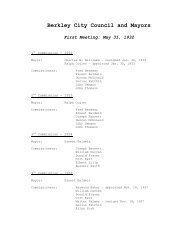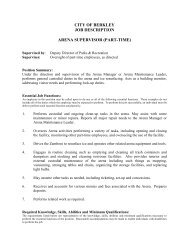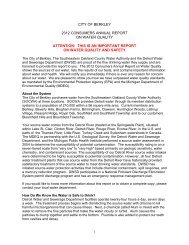You also want an ePaper? Increase the reach of your titles
YUMPU automatically turns print PDFs into web optimized ePapers that Google loves.
<strong>City</strong> <strong>of</strong> <strong>Berkley</strong>, <strong>MI</strong><br />
Historical Timeline<br />
1815<br />
Before 1815, the area along the Saginaw Trail, north <strong>of</strong> Twelve Mile Road (now Roseland Cemetery) was<br />
the site <strong>of</strong> Ottawa Indian Gardens. The Gardens included irrigation ditches and already had trees<br />
growing on them that were more than 4 feet around when the first settlers arrived.<br />
1815<br />
Before 1815 there was a flowing artesian spring near Coolidge and Wiltshire that was the water supply<br />
for the village until 1926. It is now directed to the Twelve Town Drain.<br />
1825<br />
Mary Ann Chappell, "Mother Handsome," had an Inn on the west side <strong>of</strong> Saginaw Trail just north <strong>of</strong><br />
Eleven Mile Road<br />
1825<br />
Augustus Ellwood, came to <strong>Berkley</strong> in 1831 and built a house in 1845 at 4030 Thomas. Ellwood Avenue is<br />
named after this family.<br />
1825<br />
The Quick family came to <strong>Berkley</strong> in 1831. Their home still stands at 2440 Oxford.<br />
1829<br />
Lyman H. Blackmon bought land on both sides <strong>of</strong> Coolidge from Twelve Mile to Catalpa. The home still<br />
stands and is now the Sawyer's Funeral Home. Mr. Blackmon donated a half acre <strong>of</strong> land in 1834 for a<br />
school for School District #7 to be built on the northeast corner <strong>of</strong> Coolidge and Catalpa. That school was<br />
in use before 1840 to 1901.<br />
1830<br />
John Benjamin bought land on both sides <strong>of</strong> Saginaw Trail north <strong>of</strong> Twelve Mile Road including Roseland<br />
Cemetery and St. Johns' Woods. The Ottawa Indians tended gardens within the southwest part <strong>of</strong><br />
cemetery.<br />
1832<br />
Robert W. Brown's home is still standing at Eleven Mile and Tyler.<br />
1833<br />
John McClelland's farm house still stands at 2178 Greenfield south <strong>of</strong> Oxford.<br />
1834<br />
Hamlet Harris' 1844 farm house still stands at 1364 Catalpa.
<strong>City</strong> <strong>of</strong> <strong>Berkley</strong> - Historical Timeline<br />
page 2<br />
1835<br />
The Hoagland family purchased land where the Post Office and drug store now stand. Their log cabin<br />
was still standing near Twelve Mile and Wakefield until about 1918.<br />
1870<br />
The Remole family came and their house still stands at 1608 Eleven Mile Road.<br />
1900<br />
1900 U.S. Census for Royal Oak Township - population was 468 people.<br />
1901<br />
Baker School at the northeast corner <strong>of</strong> Coolidge and Eleven Mile used until 1920.<br />
1910<br />
The first phone line was strung along Eleven Mile Road and links ten subscribers<br />
1913<br />
The farms were all sold and made into subdivisions between 1913 and 1919.<br />
1918<br />
School District changes from a primary district to a graded district.<br />
1918<br />
The "Tar Paper School" was used between 1918 and 1920 on the northeast side <strong>of</strong> Catalpa and Coolidge.<br />
1919<br />
Construction was begun on <strong>Berkley</strong> School on <strong>Berkley</strong> Avenue north <strong>of</strong> Catalpa.<br />
1919<br />
Electric lights came to <strong>Berkley</strong><br />
1919<br />
First outing by <strong>Berkley</strong> neighbors and friends which was the origin <strong>of</strong> <strong>Berkley</strong> Days<br />
1920<br />
Olive Leaf, I.O.O.F. formed<br />
1920<br />
Masons groups formed<br />
1920<br />
Radio Temple organized at Twelve Mile and Gardner. The radio talks always welcomed people to<br />
<strong>Berkley</strong>.
<strong>City</strong> <strong>of</strong> <strong>Berkley</strong> - Historical Timeline<br />
page 3<br />
1920<br />
<strong>Berkley</strong> Community Church organized<br />
1921<br />
Angell School is authorized, located at Beverly and Bacon.<br />
1922<br />
<strong>Berkley</strong> Community Church purchased the "Tar Paper School." Using children's wagons, baby buggies,<br />
and cars the church was relocated to the corner <strong>of</strong> Wiltshire and Kipling . The first meeting was held in<br />
the "new" church September 10, 1922.<br />
1922<br />
Phone service is now provided 24 hours a day.<br />
1923<br />
<strong>Berkley</strong> Village Charter written.<br />
1923<br />
Our Lady <strong>of</strong> Refuge Catholic Church was built on Catalpa on the property that is now Community Field.<br />
1923<br />
Trinity Lutheran Church founded.<br />
1923<br />
First General Election for the Village <strong>of</strong> <strong>Berkley</strong><br />
1923<br />
The first village purchase was for a tractor used for pulling long lines <strong>of</strong> cars through the mud and snow<br />
to Woodward for the drive to and from work as well as any work the city needed done.<br />
1924<br />
House numbers are being placed in the village.<br />
1924<br />
First water main in place to receive water from Royal Oak.<br />
1924<br />
First Police Department formed comprised <strong>of</strong> Police Chief Allen L. McCabe and four patrolmen. Chief<br />
Allen was also appointed Fire Chief.<br />
1924<br />
First Fire Engine, Type #25 American LaFrance is purchased.<br />
1925<br />
Marion L. Burton School and Pattengill School are opened.
<strong>City</strong> <strong>of</strong> <strong>Berkley</strong> - Historical Timeline<br />
page 4<br />
1926<br />
First <strong>Berkley</strong> Days festival begun by Independent Order <strong>of</strong> Odd Fellows celebrated the extension <strong>of</strong><br />
Coolidge Highway from Twelve Mile Road to Woodward Avenue<br />
1926<br />
Twelve Mile Road paved<br />
1926<br />
Water Tower is built. The first well hit water at 219 feet.<br />
1927<br />
Coolidge Highway south <strong>of</strong> Twelve Mile Road is paved.<br />
1927<br />
The infrastructure for <strong>Berkley</strong> - sewers, water, sidewalks, streets, etc. - is being created.<br />
1927<br />
<strong>Berkley</strong> Commission votes to purchase property at Coolidge and Rosemont for a new village hall and will<br />
include police and fire facilities.<br />
1927<br />
The Catholic Church located at what is now Community Field traded property and in exchange received<br />
the property at Coolidge and Harvard. Shortly thereafter the church was moved to the new location.<br />
1928<br />
<strong>Berkley</strong> Village Hall, Police and Fire station is built. It is the only building in the area that has a real jail<br />
and all the local villages hold their prisoners in the <strong>Berkley</strong> jail.<br />
1928<br />
The "Tar Paper School" was used between 1918 and 1920 on the northeast side <strong>of</strong> Catalpa and Coolidge.<br />
1928<br />
Woman's Club volunteered to maintain a library. From 1928 to 1947 the library was located on the 2nd<br />
floor in the northwest corner <strong>of</strong> the <strong>City</strong> Hall building.<br />
1928<br />
The Leone family built a theatre on Twelve Mile Road. An explosion and fire destroy the theater and<br />
nearby stores.<br />
1929<br />
Methodist Church founded on Twelve Mile in a store front at the corner <strong>of</strong> <strong>Berkley</strong> Ave. and Twelve Mile<br />
Road.
<strong>City</strong> <strong>of</strong> <strong>Berkley</strong> - Historical Timeline<br />
page 5<br />
1929<br />
Stock Market crashes and 90% <strong>of</strong> residents living in <strong>Berkley</strong> lose their jobs.<br />
1929<br />
U.S. Federal Census lists 5,558 people in the Village <strong>of</strong> <strong>Berkley</strong><br />
1930<br />
In January, School District #7 placed all students on a half day schedule and stopped all gym, art, and<br />
music classes. People had no money to pay their taxes.<br />
1930<br />
Street lights in <strong>Berkley</strong> were turned <strong>of</strong>f because the people had no money to pay their taxes.<br />
1931<br />
<strong>Berkley</strong> and Angell Schools remain open, but Pattengill and Burton Schools are closed.<br />
1931<br />
Frank Irons became the Chief <strong>of</strong> Police. The present Fire and Police Building is named after him.<br />
1932<br />
Village <strong>of</strong> <strong>Berkley</strong> becomes a <strong>City</strong> and the taxes are lower.<br />
1932<br />
LaSalette Fathers take over the Parish <strong>of</strong> Our Lady <strong>of</strong> Refuge.<br />
1932<br />
Methodist Church built.<br />
1934<br />
<strong>Berkley</strong> High School holds its first outdoor graduation ceremony at Angell School grounds for 54<br />
graduates and 1000 attendees.<br />
1939<br />
<strong>Berkley</strong> Advance, a weekly paper, is founded by Jerry Neff.<br />
1941<br />
Pearl Harbor is attacked by the Japanese and the United States declares war on Japan and Germany.<br />
1941<br />
Japanese land in Alaska and also shell the Pacific coastline.<br />
1942<br />
Gethsemane Lutheran Church was organized.
<strong>City</strong> <strong>of</strong> <strong>Berkley</strong> - Historical Timeline<br />
page 6<br />
1942<br />
Pattengill School reopens<br />
1942<br />
St. John Woods Association founded.<br />
1943<br />
1st two classrooms are started in the basement <strong>of</strong> LaSalette Church.<br />
1943<br />
<strong>Berkley</strong> Service Honor Roll erected on <strong>City</strong> Hall lawn.<br />
1943<br />
<strong>Berkley</strong> voters approve a city manager form <strong>of</strong> government, the first <strong>City</strong> Manager was David King.<br />
1945<br />
World War II ends<br />
1946<br />
Greenfield Presbyterian Church founded<br />
1946<br />
LaSalette School is opened.<br />
1947<br />
VFW Post 9222 was organized and granted a charter by Congress.<br />
1947<br />
The library moves to a rented store at 2657 Coolidge.<br />
1947<br />
<strong>Berkley</strong> becomes the first local fire department to have a two-way radio in the fire truck.<br />
1949<br />
Tyler (now Avery) School and Oxford School are built.<br />
1951<br />
Hamilton (now Rogers) School built.<br />
1952<br />
Library moved to a larger building at 2799 Coolidge which was formerly occupied by Modern<br />
Engineering Company.<br />
1953<br />
New Church built by Methodist Congregation on Twelve Mile Road.
<strong>City</strong> <strong>of</strong> <strong>Berkley</strong> - Historical Timeline<br />
page 7<br />
1954<br />
Two hundred volunteers go door to door to raise funds to build a community recreation center.<br />
1954<br />
<strong>City</strong> Council hires an architect to design a new <strong>City</strong> Hall. There is much opposition because more than<br />
$20,000 taken from the water department funds.<br />
1955<br />
Anderson Middle School is built on the land that was originally owned by the Catholic Church and where<br />
Our Lady <strong>of</strong> Refuge Parish was built. It is now Community Field and Anderson Middle School faces<br />
Catalpa Drive.<br />
1956<br />
Norup Middle School is built in Oak Park.<br />
1957<br />
New <strong>Berkley</strong> <strong>City</strong> Hall is attached to the east side <strong>of</strong> the Old <strong>City</strong> Hall.<br />
1958<br />
<strong>Berkley</strong> stages its first Christmas Parade<br />
1960<br />
New municipal court replaces a Justice <strong>of</strong> the Peace court.<br />
1963<br />
New rectory is completed for Our Lady <strong>of</strong> LaSalette<br />
1963<br />
New Library building, located at 3155 Beverly at Beverly, was completed in December 1964<br />
1964<br />
Tyndall School is built in Oak Park.<br />
1965<br />
New Parish Church <strong>of</strong> Our Lady <strong>of</strong> LaSalette is dedicated.<br />
1967<br />
Municipal Court becomes 45-A District Court .<br />
1970<br />
<strong>Berkley</strong> Police and Fire Departments combine into Public Safety Department.<br />
1973<br />
New gymnasium built at <strong>Berkley</strong> High School, and is referred to as "The gym Bruce Flowers built".
<strong>City</strong> <strong>of</strong> <strong>Berkley</strong> - Historical Timeline<br />
page 8<br />
1978<br />
<strong>Berkley</strong> Elementary School is demolished<br />
1979<br />
Gethsemane Lutheran merged with St. Peter's Lutheran <strong>of</strong> Detroit to form Cana Lutheran Church.<br />
1983<br />
Cable TV Channel 32, the city's first municipal access channel is established<br />
1983<br />
Oxford School is closed and those students sent to Angell. The School District Offices were moved to<br />
Oxford School and Adult Education Classes were continued in the building<br />
1986<br />
<strong>Berkley</strong> High School auditorium constructed<br />
1989<br />
The new Public Safety Building opens and is dedicated to Police Chief Frank Irons, a long time Police<br />
Chief in <strong>Berkley</strong>.<br />
1998<br />
Re-dedication <strong>of</strong> expanded and renovated Library Building<br />
2003<br />
Launch <strong>of</strong> the <strong>City</strong>’s first website<br />
2007<br />
Observed the 75th Anniversary <strong>of</strong> the <strong>City</strong> <strong>of</strong> <strong>Berkley</strong>.<br />
2009<br />
The <strong>City</strong> <strong>of</strong> <strong>Berkley</strong> launched the first <strong>of</strong> its social media sites via Facebook and Twitter.


